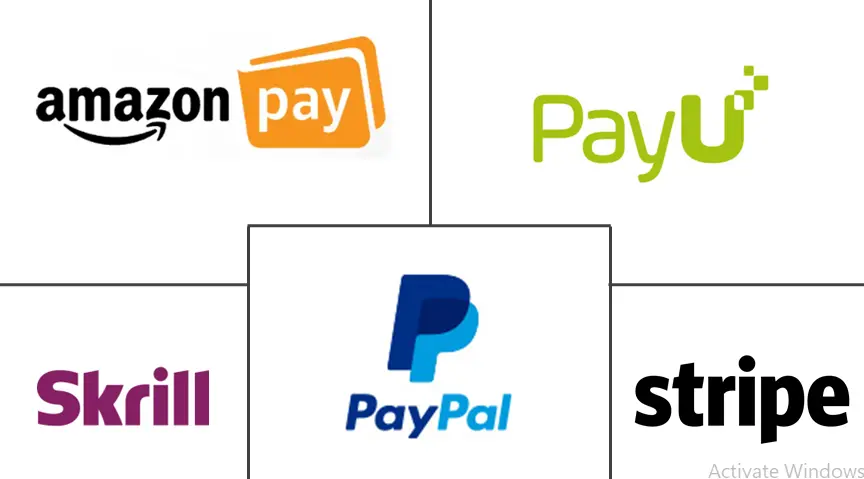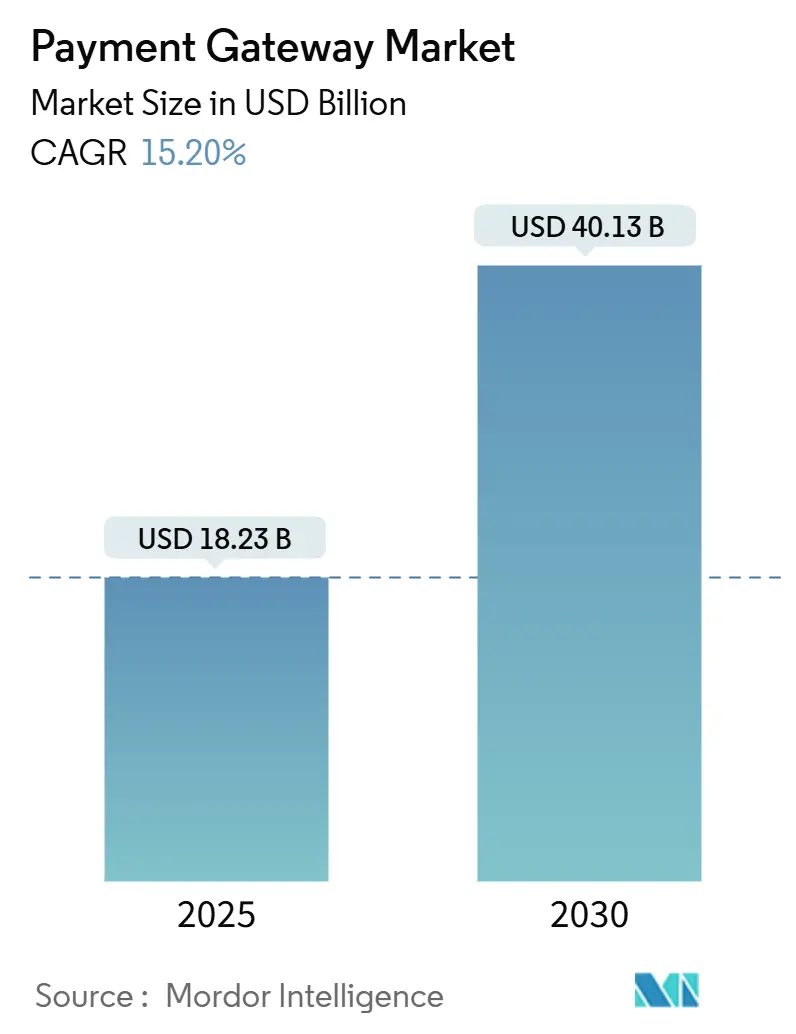
Payment Gateway Market Analysis by Mordor Intelligence
The payment gateway market size is estimated at USD 18.23 billion in 2025 and is projected to climb to USD 40.13 billion by 2030, reflecting a solid 15.20% CAGR over the forecast period. The industry’s growth is underpinned by rapid digital-commerce expansion, rising real-time payment adoption, and intensifying regulatory focus on security. Adoption of Unified Payments Interface (UPI) and other instant-payment rails is triggering gateway upgrades that handle high-velocity authentication requests, while Europe’s PSD2 Strong Customer Authentication (SCA) rules are accelerating tokenized, 3-DS-ready deployments. Competitive momentum is reinforced by megadeals such as Global Payments’ agreement to acquire Worldpay and FIS’s purchase of Global Payments’ Issuer Solutions arm, which are reshaping scale economics. Hosted solutions retain the largest customer base, yet self-hosted architectures are advancing on data-sovereignty concerns. The payment gateway market also faces margin pressure from interchange-fee escalation and a proliferation of cross-border chargeback fraud, compelling providers to embed advanced fraud-mitigation AI.
Key Report Takeaways
- By enterprise size, large enterprises led with 68% share of the payment gateway market in 2024; SMEs are positioned for a 17.2% CAGR to 2030 as Tap to Phone democratizes acceptance.
- By type, hosted gateways maintained 62% revenue share in 2024, whereas self-hosted solutions are forecast to grow 15.8% CAGR through 2030.
- By channel, Web checkout still generates 70.1% of 2024 transaction value, but mobile in-app payments are expected to grow at 19.3% CAGR through 2030.
- By end-user industry, retail and e-commerce held 45.3% share in 2024; healthcare is the fastest-growing vertical at an 18.5% CAGR through 2030.
- By geography, Asia-Pacific captured 38% payment gateway market share in 2024, while the Middle East is on track for an 18.1% CAGR through 2030.
Global Payment Gateway Market Trends and Insights
Drivers Impact Analysis
| Driver | (~) % Impact on CAGR Forecast | Geographic Relevance | Impact Timeline |
|---|---|---|---|
| Explosion of real-time payment rails accelerating gateway adoption in Asia | +3.2% | Asia-Pacific core, spill-over to Middle East | Medium term (2-4 years) |
| Cross-border e-commerce growth driving demand for multi-currency routing, especially among European SMEs | +2.8% | Europe and North America, expanding to APAC | Long term (≥ 4 years) |
| Regulatory mandates (e.g., PSD2-SCA) forcing upgrades to tokenised 3-DS-ready gateways | +2.1% | Europe, with regulatory spillover to other regions | Short term (≤ 2 years) |
| Surge in BNPL checkout options expanding API calls per transaction | +1.9% | Global, with concentration in developed markets | Medium term (2-4 years) |
| Contactless-wallet boom in grocery chains spurring omnichannel gateway deployment | +1.5% | North America and Europe, emerging in APAC | Short term (≤ 2 years) |
| Source: Mordor Intelligence | |||
Explosion of Real-Time Payment Rails Accelerating Gateway Adoption in Asia
Real-time payment infrastructure is reshaping gateway demand, with India’s UPI and Indonesia’s BI-FAST exhibiting transaction growth that outpaces card schemes. [1] BankservAfrica, “Real-time payments in India, Indonesia expected to see largest growth,” bankservafrica.com Processing cost reductions of 50-90% versus legacy networks incentivize merchants to migrate. Gateways able to orchestrate authentication flows across more than 80 instant-payment systems gain a first-mover advantage, especially as volume is projected to reach 512 billion real-time transactions by 2027. Asia’s mobile-first consumer base leapfrogs card rails, accelerating demand for API-rich gateways that can consolidate diverse real-time schemes into single merchant integrations.
Cross-Border E-Commerce Growth Driving Demand for Multi-Currency Routing
European SMEs selling on global marketplaces need gateways that support intelligent currency routing, alternative payment methods, and local acquiring to reduce decline rates. With European e-commerce valued at EUR 887 billion (USD 960 billion) in 2023, cross-border flows elevate demand for dynamic currency conversion and real-time FX risk management. Gateways that mask regulatory complexity while offering transparent settlement attract SMEs that lack treasury expertise. Investments in local licence acquisition and data residency help providers differentiate.
Regulatory Mandates Forcing Tokenised, 3-DS-Ready Gateways
PSD2 has already compelled Strong Customer Authentication; the forthcoming PSD3 proposal broadens scope to Authorized Push Payment fraud prevention. [2]OneSpan, “PSD3 proposes changes to SCA & APP fraud prevention,” onespan.com Gateways must offer multi-factor authentication, network tokenization, and real-time risk scoring that comply with device-based token requirements from authorities such as the Reserve Bank of India. Compliance investment drives consolidation, raising barriers for niche players while opening market share for providers that scale regulatory tooling across jurisdictions. Value-added token vaulting is emerging as a revenue stream, reducing merchant PCI burden.
Surge in BNPL Checkout Options Expanding API Calls per Transaction
BNPL usage by 43% of European consumers increases gateway traffic because every installment plan triggers credit decisioning, schedule creation, and settlement events. SeQura’s 55% revenue jump after integrating with Stripe underlines the uplift for merchants deploying BNPL-optimized gateways. Retailers in healthcare, grocery, and travel embed BNPL to soften inflation’s impact on consumers, heightening API complexity. Providers with pre-integrated BNPL workflows capture incremental transaction fees and deepen merchant stickiness.
Restraints Impact Analysis
| Restraint | (~) % Impact on CAGR Forecast | Geographic Relevance | Impact Timeline |
|---|---|---|---|
| Rising scheme fees squeezing gateway margins for micro-transactions | -1.8% | Global, particularly impacting high-volume, low-value segments | Short term (≤ 2 years) |
| Persistent cross-border chargeback fraud undermining merchant trust | -1.2% | Global, with concentration in cross-border e-commerce | Medium term (2-4 years) |
| Data-localisation laws complicating token-vault architectures | -0.9% | India, Brazil, Russia, with regulatory spillover effects | Long term (≥ 4 years) |
| Source: Mordor Intelligence | |||
Rising Scheme Fees Squeezing Gateway Margins for Micro-Transactions
Interchange structures set by card networks can exceed the transaction value for sub-USD 5 purchases, particularly when flat-rate components apply. Recent “small merchant” programs by Visa and Mastercard lowered certain rates but have not solved the structural mismatch for sectors like digital content or transit. Congressional hearings have reignited scrutiny of swipe fees, adding regulatory uncertainty that complicates gateway pricing models. Providers are piloting account-to-account schemes and wallet-based micro-payment rails to defend margins while offering merchants alternative acceptance options.
Persistent Cross-Border Chargeback Fraud Undermining Merchant Trust
Social-engineering attacks and first-party misuse drive elevated dispute ratios in cross-border commerce, eroding merchant enthusiasm for new payment types. The Merchant Risk Council notes that nearly half of merchants faced refund abuse in 2024, raising the cost of fraud-mitigation investments. While AI-led risk engines improve detection, fraudsters iterate quickly, forcing gateways to balance one-hour settlement goals with more stringent prescreening, a trade-off documented by the Financial Stability Board. Merchants gravitate toward providers with distributed data networks that detect anomalies across regions without violating data-localization statutes.
Segment Analysis
By Type: Hosted Dominance Meets Rising Preference for Control
Hosted gateways account for 62% of payment gateway market share in 2024 as merchants value outsourced PCI compliance and turnkey onboarding. Many SMEs prefer managed environments that bundle fraud tools and currency conversion under a single contract. Large enterprises, however, increasingly deploy self-hosted or hybrid models to customize routing algorithms, maximize authorization ratios, and meet jurisdiction-specific data-localization mandates. The payment gateway market size will continue tilting toward flexible deployment options as regulators intensify scrutiny of cross-border data flows.
Self-hosted solutions, projected to expand at 15.8% CAGR to 2030, attract merchants in healthcare and financial services that require direct control over token vaults and fraud-risk models. Gateway vendors are therefore offering containerized micro-services that merchants can deploy on owned infrastructure while still connecting to cloud-based reconciliation services. This modularity ensures adherence to Strong Customer Authentication mandates while allowing selective data residency. The approach also supports lower-latency connections to regional acquirers, improving approval rates in local markets.
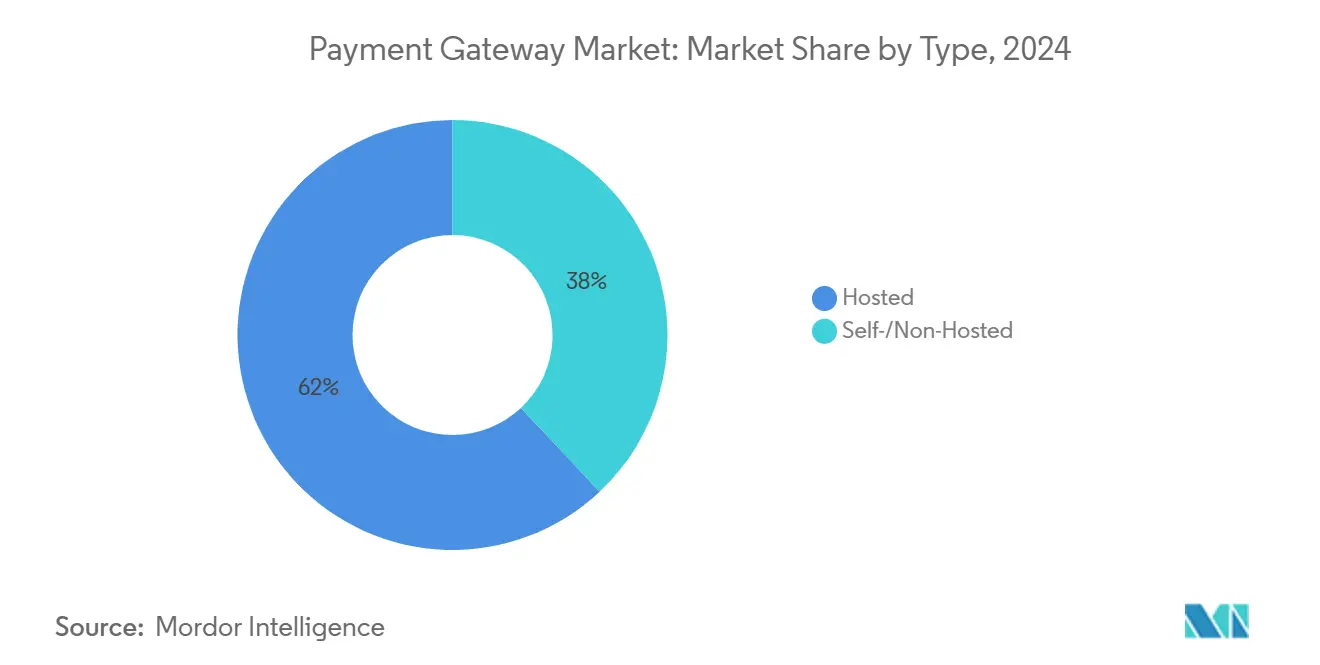
Note: Segment shares of all individual segments available upon report purchase
By Enterprise Size: Democratization Unlocks SME Upside
Large organizations contributed 68% of global revenue in 2024, leveraging orchestration engines that route transactions across dozens of acquirers to shave basis-points off processing costs. These enterprises deploy A/B testing on authorization logic, integrate real-time machine-learning signals, and contract with redundant gateway providers to mitigate downtime risk. The payment gateway market size for SMEs is poised for a structural lift as low-cost cloud platforms and Tap to Phone solutions reduce adoption barriers.
SMEs expanding into cross-border e-commerce require gateways that automate FX conversion and offer straightforward pricing. Integrated Software Vendors embed payment acceptance within accounting and point-of-sale suites, accelerating merchant onboarding and improving stickiness. Progressive regulators encourage SME digitalization, further propelling adoption. Consequently, the payment gateway market will witness intensifying competition between pure-play payment facilitators and established processors courting the SME base.
By Channel: Mobile In-App Leads Transaction Velocity
Web checkout still generates 70.1% of 2024 transaction value, but mobile in-app payments are growing at 19.3% CAGR as super-apps consolidate consumer attention, especially in Asia. In-app environments enable one-click tokenized payments and contextual upselling, driving higher conversion rates. The payment gateway market size attached to mobile is therefore set to surpass web growth by 2030 as merchants reconstruct customer journeys around smartphones.
Unified commerce strategies require gateways to harmonize mobile, web, and in-store channels. Retailers adopting scan-and-go and QR-based payments need token vaults that persist across touchpoints without violating PSD2’s dynamic-linking rules. Gateways that surface omnichannel reporting dashboards and loyalty integrations help merchants optimize marketing spend while maintaining compliance, ensuring they remain central to evolving checkout paradigms.
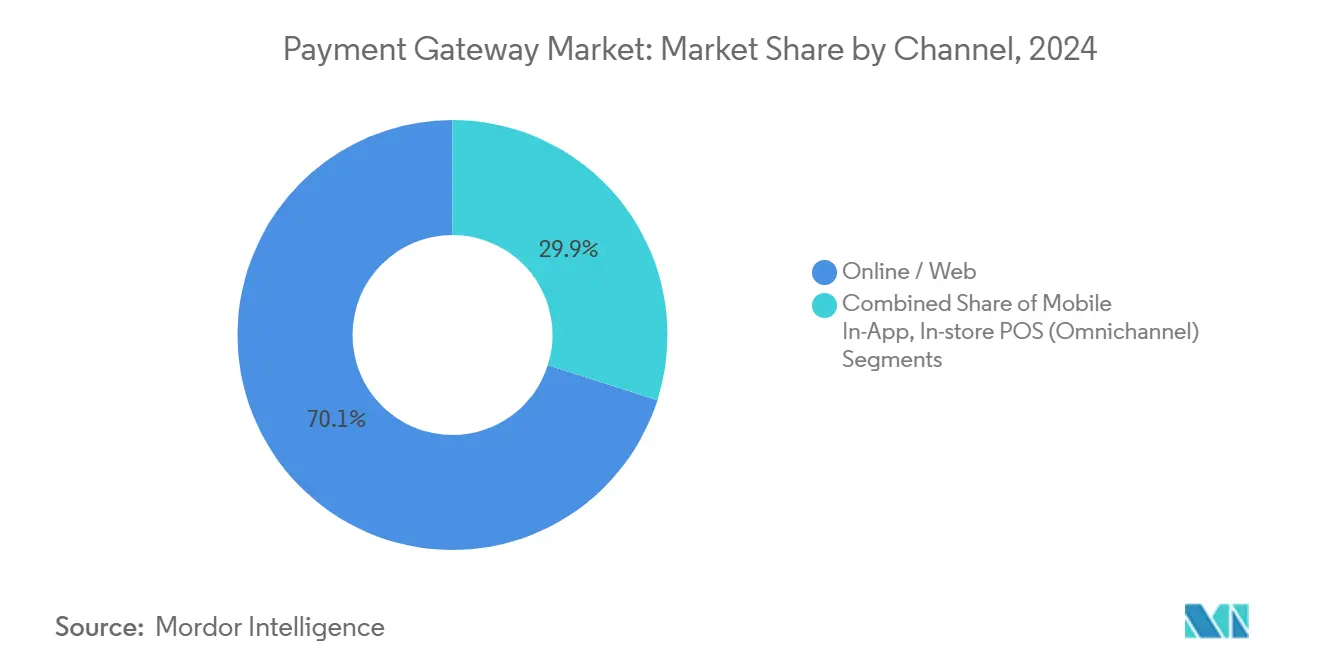
Note: Segment shares of all individual segments available upon report purchase
By End-User Industry: Healthcare Outpaces Retail Momentum
Retail and e-commerce maintained a 45.3% payment gateway market share in 2024, propelled by perpetual online retail expansion and supplemental in-store digitization. Omnichannel expectations pressure retailers to integrate returns, loyalty, and inventory systems with the payment stack. Meanwhile, healthcare’s 18.5% CAGR through 2030 signals a paradigm shift, as providers require secure gateways capable of handling insurance co-pays, recurring telehealth subscriptions, and financing options for elective procedures.
HIPAA mandates drive preference for tokenization and segregated data environments. Gateways addressing these requirements gain entry into hospital networks traditionally served by legacy clearinghouses. In addition, patient-financing models rely on split settlements among payers, providers, and lenders, increasing orchestration complexity. The payment gateway industry therefore sees healthcare as a high-margin expansion frontier relative to commodity retail processing.
Geography Analysis
Asia-Pacific leads the payment gateway market with a 38% revenue share in 2024, anchored by India’s UPI, Indonesia’s BI-FAST, and China’s ubiquitous wallet ecosystems that together process billions of instant transactions daily. Government initiatives such as Singapore’s SGQR and the ASEAN Regional Payment Connectivity project promote interoperability, fostering multi-currency gateways capable of tokens bridging retail accounts and wallets. Data-localization edicts, particularly the Reserve Bank of India’s on-soil storage requirement, compel gateway vendors to deploy regional data centers or partner with domestic cloud providers.
The Middle East registers the fastest CAGR at 18.1% through 2030, propelled by national-level strategies such as Saudi Arabia’s Vision 2030 cashless targets and the UAE’s instant-payments platform launch. Domestic schemes like Saudi Payments’ sarie and Bahrain’s BenefitPay push acquirer-agnostic routing, creating openings for API-centric gateway brands. Foreign providers that combine Sharia-compliant financing options and Arabic-language support expand share swiftly.
Europe remains a sophisticated yet opportunity-rich market as PSD2 enforcement stabilizes fraud ratios and the European Central Bank drives pan-European instant-payment initiatives. [3]European Central Bank, “Enhancing cross-border payments in Europe and beyond,” ecb.europa.eu Cross-border e-commerce volume from SMEs heightens demand for gateways integrating iDEAL, Sofort, and Bancontact. North America’s uptake of FedNow and RTP modernizes settlement, while interchange politics create cost-recovery challenges for micro-transaction gateways. South America, spearheaded by Brazil’s Pix and LGPD data framework, is transitioning from cash to mobile wallets at record speed. Africa’s fragmented banking infrastructure demands gateways compatible with mobile-money schemes, making partnership ecosystems pivotal for penetration.
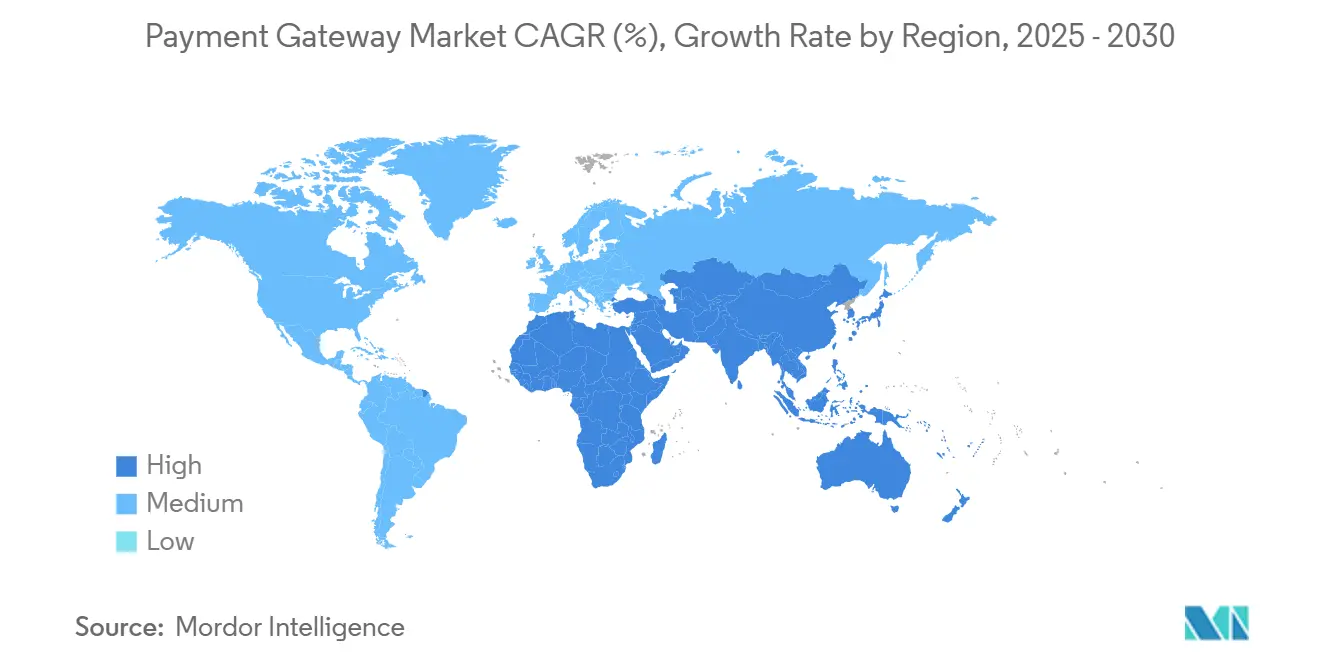
Competitive Landscape
Traditional processors and fintech-native platforms intensify rivalry as scale and agility define success metrics. Stripe processed USD 1.4 trillion in 2024 payments, achieved full-year profitability, and funneled resources into machine-learning risk engines that optimize authorization at the millisecond level. Adyen processed EUR 1.29 trillion (USD 1.39 trillion) and sustained a 50% EBITDA margin, promoting “Unified Commerce” that unites online and point-of-sale flows into a single ledger. Global Payments’ planned acquisition of Worldpay for USD 22.7 billion positions the combined entity with more than 6 million merchant locations, affirming a consolidation thesis built on operating leverage.
Technology differentiation gravitates toward AI-driven fraud detection, token orchestration, and adaptive routing. Providers allocate R&D budgets to ISO 20022 messaging compatibility, low-code developer tools, and compliance automation that adjusts authentication flows country-by-country. Embedded finance broadens the competitive field; software vendors such as Shopify, Intuit, and Olo incorporate white-label gateways, abstracting payment complexity for end merchants. Consequently, standalone gateway providers must cultivate API flexibility and partnership depth to remain integral to software ecosystems.
Vertical specialization emerges as a hedge against commoditization. In healthcare, HIPAA-compliant gateways like Sphere and RevSpring penetrate hospital EMR integrations. In B2B trade, payable-automation firms bundle virtual-card issuance with gateways, monetizing supplier payments. Geographic specialization also flourishes as companies such as dLocal focus on emerging-market payout rails. While scale offers pricing power, niche expertise garners sticky margins, creating room for both mega-providers and specialized challengers.
Payment Gateway Industry Leaders
-
PayPal Holdings, Inc.
-
Amazon Pay (Amazon.com, Inc.)
-
Stripe, Inc.
-
PayU Group
-
Skrill Ltd (Paysafe)
- *Disclaimer: Major Players sorted in no particular order
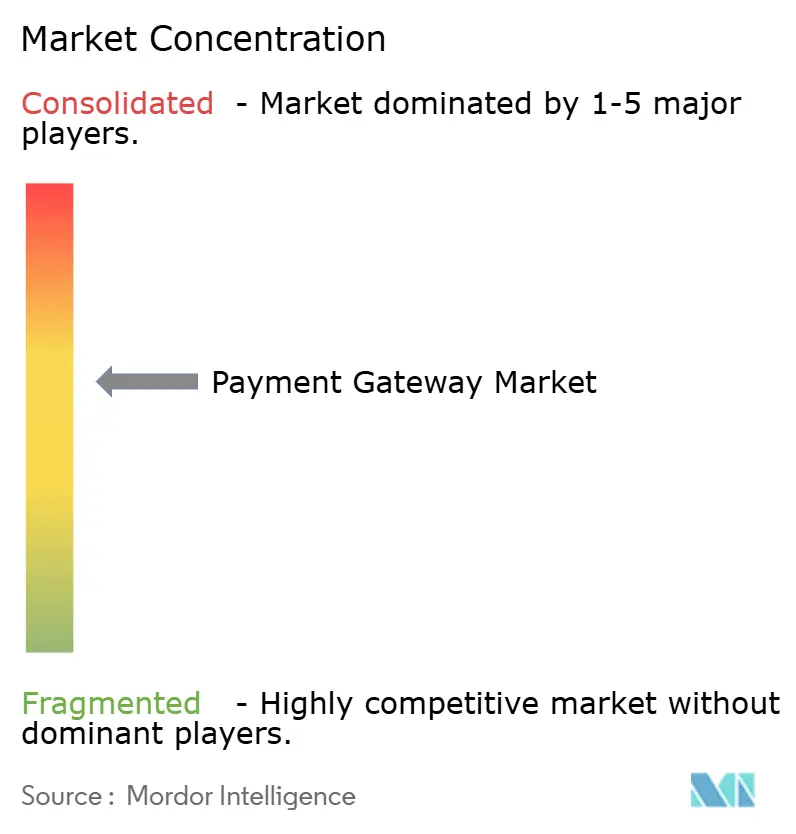
Recent Industry Developments
- April 2025: Global Payments agreed to acquire Worldpay for USD 22.7 billion. The move expands acquiring scale, elevates omnichannel capability, and targets USD 600 million cost synergies, positioning the combined firm to negotiate sharper network fees while cross-selling value-added services.
- April 2025: FIS purchased Global Payments’ Issuer Solutions unit for USD 12 billion and divested its own Worldpay stake for USD 6.6 billion. Strategically, FIS doubles down on issuer processing and data-driven loyalty while exiting lower-margin merchant acquiring.
- April 2025: IFX Payments announced plans to buy Argentex Group, bolstering FX options and e-money capabilities to underpin multi-currency gateway functionality for corporate clients.
- March 2025: Visa reported 200% Tap to Phone growth, underscoring strategy to penetrate micro-merchant segments with minimal hardware costs and reinforcing network volumes in cash-heavy geographies.
Research Methodology Framework and Report Scope
Market Definitions and Key Coverage
Our study defines the global payment gateway market as the aggregate gross revenue earned by technology platforms that securely authorize, route, and settle card, account-to-account, and wallet transactions initiated through remote or in-app checkouts for goods or services.
Scope exclusion: The model omits pure-play acquirers, offline POS hardware sales, and in-house gateways bundled free within merchant SaaS suites.
Segmentation Overview
- By Type
- Hosted
- Self-/Non-Hosted
- By Enterprise Size
- Small and Medium Enterprises (SME)
- Large Enterprises
- By Channel
- Online / Web
- Mobile In-App
- In-store POS (Omnichannel)
- By End-User Industry
- Retail and E-commerce
- Travel and Hospitality
- Banking, Financial Services and Insurance (BFSI)
- Media and Entertainment
- Other End-user Industries
- By Geography
- North America
- United States
- Canada
- Mexico
- Europe
- Germany
- United Kingdom
- France
- Nordics
- Rest of Europe
- Asia
- China
- India
- Japan
- South Korea
- South-East Asia
- Rest of Asia
- South America
- Brazil
- Argentina
- Rest of South America
- Middle East and Africa
- Middle East
- GCC
- Turkey
- Rest of Middle East
- Africa
- South Africa
- Nigeria
- Rest of Africa
- Middle East
- North America
Detailed Research Methodology and Data Validation
Primary Research
Mordor analysts spoke with gateway product heads, e-commerce finance managers, PSP integrators, and regional regulators across North America, Europe, Asia-Pacific, and the GCC. These discussions validated interchange pass-through assumptions, typical take-rates by channel, and emerging regulatory triggers (for example, India's data-localization push), closing gaps left by desk research.
Desk Research
We compiled foundational data from leading public sources such as the World Bank Findex, UNCTAD e-Trade readiness reports, European Central Bank SEPA statistics, Reserve Bank of India digital-payment dashboards, and the US Federal Reserve Payments Study. Company 10-Ks, prospectuses, regional banking association white papers, and reputable business media helped map fee structures and competitive shares. Subscription tools including D&B Hoovers for merchant cohorts and Dow Jones Factiva for deal tracking supplied additional depth. The sources named are illustrative; many other publications underpinned fact-checks and clarifications.
Market-Sizing & Forecasting
We first reconstructed the total remote-checkout payment pool for 2024 using top-down indicators, global retail e-commerce GMV, cross-border trade values, and instant-payment penetration. We then applied verified gateway penetration and weighted average take-rates. Supplier roll-ups of disclosed net revenue per processed dollar acted as a selective bottom-up sense-check, with variances reconciled through iterative adjustment. Key variables feeding the model include smartphone penetration, average ticket size, PCI-DSS compliance adoption, real-time payment share, and regional fraud-loss ratios. A multivariate regression baseline, refreshed annually, projects each driver to 2030. Scenario overlays test PSD2-style mandates, fee-cap shifts, and wallet adoption shocks.
Data Validation & Update Cycle
Outputs pass a two-step analyst review: variance analysis against historical series and peer benchmarks, followed by anomaly resolution. A senior reviewer signs off before publication. We refresh every twelve months and issue mid-cycle updates if material events, such as a major security mandate, distort underlying metrics.
Why Mordor's Payment Gateway Baseline Inspires Confidence
Published estimates often diverge because firms select different revenue pools, integrate processor income, or assume uniform fee compression.
Key gap drivers include whether hosted and self-hosted solutions are both counted, if domestic and cross-border flows are blended, how free-tier API volumes are treated, and the refresh cadence that captures regulatory shocks. Mordor reports only gateway fees net of interchange, updates annually, and applies country-specific FX averages, which many peers overlook.
Benchmark comparison
| Market Size | Anonymized source | Primary gap driver |
|---|---|---|
| USD 18.23 B (2025) | Mordor Intelligence | - |
| USD 26.70 B (2024) | Global Consultancy A | Includes processing & acquiring revenue, single FX rate |
| USD 32.52 B (2023) | Industry Journal B | Combines payment processor fees and POS hardware |
| USD 35.17 B (2024) | Regional Consultancy C | Applies uniform 20% take-rate, limited country splits |
These comparisons show that figures can swing widely when scope and fee logic differ. By isolating true gateway revenue, triangulating with merchant interviews, and refreshing against live regulatory data, Mordor Intelligence provides a balanced, transparent baseline that decision-makers can trace back to clear variables and repeatable steps.
Key Questions Answered in the Report
What is the current payment gateway market size?
The payment gateway market size stands at USD 18.23 billion in 2025 and is forecast to reach USD 40.13 billion by 2030.
Which region leads the payment gateway market?
Asia-Pacific leads with 38% revenue share, driven by real-time payment rails and mobile-first commerce ecosystems.
Why are hosted gateways still dominant?
Hosted models simplify PCI compliance and rapid onboarding, securing 62% of 2024 revenue even as self-hosted demand rises.
Which end-user industry is growing fastest for gateways?
Healthcare is expanding at an 18.5% CAGR through 2030 due to digital billing, telehealth, and patient-financing needs.
What is driving consolidation among gateway providers?
Scale benefits in negotiating scheme fees, regulatory compliance costs, and AI-risk investments motivate mergers like Global Payments–Worldpay and FIS–Issuer Solutions.
Page last updated on:
